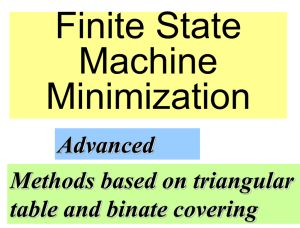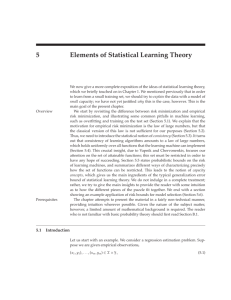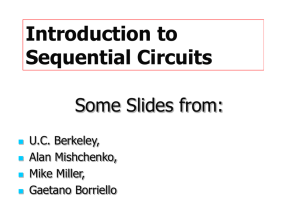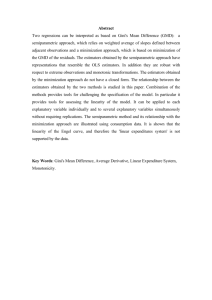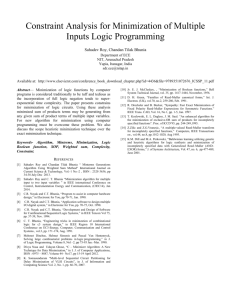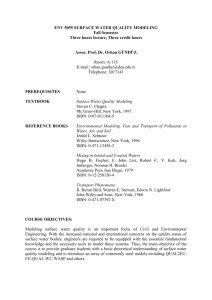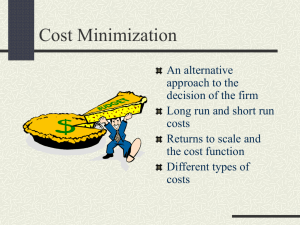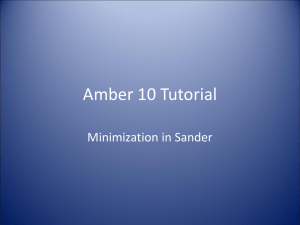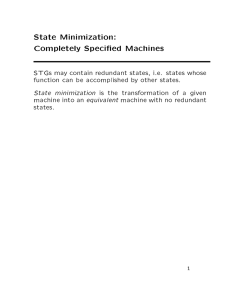State Minimization
advertisement
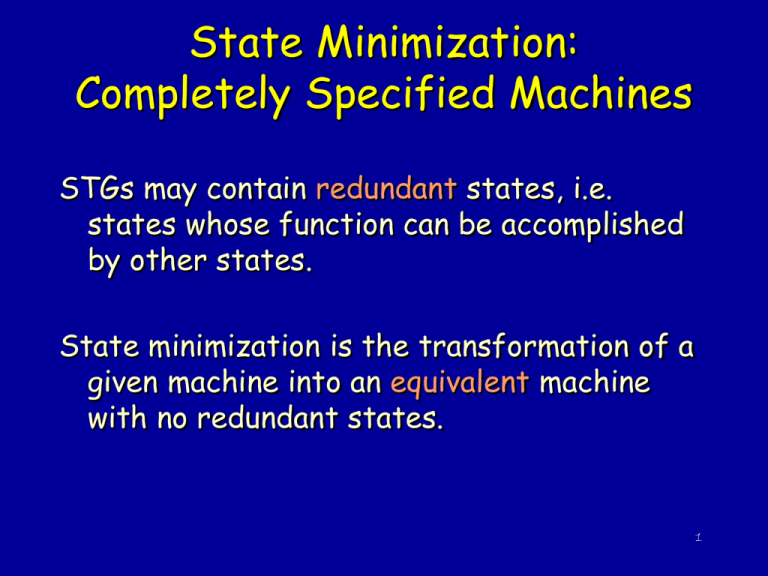
State Minimization:
Completely Specified Machines
STGs may contain redundant states, i.e.
states whose function can be accomplished
by other states.
State minimization is the transformation of a
given machine into an equivalent machine
with no redundant states.
1
State Minimization:
Completely Specified Machines
Two states, si and sj of machine M are
distinguishable if and only if there exists a finite
input sequence which when applied to M causes
different output sequences depending on whether
M started in si or sj.
Such a sequence is called a distinguishing sequence
for (si, sj).
If there exists a distinguishing sequence of length k
for (si, sj), they are said to be k-distinguishable.
2
State Minimization:
Completely Specified Machines
PS
A
B
C
D
E
F
NS, z
x=0
x=1
E, 0
D, 1
F, 0
D, 0
E, 0
B, 1
F, 0
B, 0
C, 0
F, 1
B, 0
C, 0
Example:
• states A and B are 1-distinguishable, since a 1
input applied to A yields an output 1, versus an
output 0 from B.
• states A and E are 3-distinguishable, since input
sequence 111 applied to A yields output 100, versus
an output 101 from E.
3
Completely Specified Machines
States si and sj (si ~ sj ) are said to be equivalent
iff no distinguishing sequence exists for (si, sj ).
If si ~ sj and sj ~ sk, then si ~ sk. So state
equivalence is an equivalence relation (i.e. it is a
reflexive, symmetric and transitive relation).
An equivalence relation partitions the elements of a
set into equivalence classes.
Property: If si ~sj, their corresponding X-successors,
for all inputs X, are also equivalent.
Procedure: Group states of M so that two states are
in the same group iff they are equivalent (forms a
partition of the states).
4
Completely Specified Machines
PS
A
B
C
D
E
F
NS, z
x=0
x=1
E, 0
D, 1
F, 0
D, 0
E, 0
B, 1
F, 0
B, 0
C, 0
F, 1
B, 0
C, 0
Pi : partition using distinguishing sequences of length i.
Partition:
P0 = (A B C D E F)
P1 = (A C E)(B D F)
P2 = (A C E)(B D)(F)
P3 = (A C)(E)(B D)(F)
P4 = (A C)(E)(B D)(F)
Distinguishing Sequence:
x =1
x =1; x =1
x =1; x =1; x =1
Algorithm terminates when Pk = PK+1
5
Completely Specified Machines
Outline of state minimization procedure:
• All states equivalent to each other form an
equivalence class. These may be combined into one
state in the reduced (quotient) machine.
• Start an initial partition of a single block.
Iteratively refine this partition by separating the 1distinguishable states, 2-distinguishable states and
so on.
• To obtain Pk+1, for each block Bi of Pk, create one
block of states that not 1-distinguishable within Bi ,
and create different blocks states that are 1distinguishable within Bi .
6
Completely Specified Machines
Theorem: The equivalence partition is unique.
Theorem: If two states, si and sj, of machine M are
distinguishable, then they are (n-1 )-distinguishable,
where n is the number of states in M.
Definition: Two machines, M1 and M2, are equivalent
(M1 ~ M2 ) iff, for every state in M1 there is a
corresponding equivalent state in M2 and vice versa.
Theorem. For every machine M there is a minimum
machine Mred ~ M.
Mred is unique up to isomorphism.
7
Completely Specified Machines
Reduced machine obtained from previous example:
PS
P4 = (A C)(E)(B D)(F)
=
PS
NS, z
x=0
x=1
, 0
, 1
, 0
, 1
, 0
, 0
, 0
, 0
A
B
C
D
E
F
NS, z
x=0
x=1
E, 0
D, 1
F, 0
D, 0
E, 0
B, 1
F, 0
B, 0
C, 0
F, 1
B, 0
C, 0
8
State Minimization of CSMs:
Complexity
Algorithm DFA ~ DFAmin
Input: A finite automaton M = (Q, , , q 0, F ) with no
unreachable states.
Output: A minimum finite automaton M’ = (Q’, , ’, q ’0, F’ ).
Method:
1. t :=2; Q0:= { undefined }; Q1:=F; Q2:= Q\F.
2. while there is 0 < i t, a with (Qi,a) Qj, for all j t
do (a) Choose such an i, a , and j t with (Qi,a) Qj .
(b) Qt +1 := {q Qi | (q,a) Qj };
Qi := Qi \ Qt +1;
t := t +1.
end.
9
State Minimization of CSMs:
Complexity
3. (* Denote
[q ] the equivalence class of state q , and
{Qi } the set of all equivalence classes.
*)
Q’ := {Q1, Q2, ..., Qt }.
q ’0 := [q0].
F’ := { [q] Q’ | q F }.
’ ( [q], a) := [(q,a)] for all q Q, a .
10
State Minimization of CSMs:
Complexity
Standard implementation: O (kn 2), where n =|Q| and
k = ||
Modification of the body of the while loop:
1. Choose such an i, a , and choose j1,j2 t with
j1 j2, (Qi,a) Qj1 , and (Qi,a) Qj2 .
2. If |{q Qi | (q,a) Qj1}| |{q Qi | (q,a) Qj2}|
then Qt +1 := {q Qi | (q,a) Qj1 }
else Qt +1 := {q Qi | (q,a) Qj2 } fI;
Qi := Qi \ Qt+1;
t := t +1.
(i.e. put smallest set in t +1 )
11
State Minimization of CSMs:
Complexity
Note: |Qt +1| 1/2|Qi|. Therefore, for all q Q, the
name of the class which contains a given state q
changes at most log(n ) times.
Goal: Develop an implementation such that all
computations can be assigned to transitions
containing a state for which the name of the
corresponding class is changed.
Suitable data structures achieve an O (kn log n)
implementation.
Details in N. Blum IPL ‘96
[Originial O (kn log n) algorithm in Hopcroft 1971]
12
State Minimization of CSMs:
BDD Implementation
X and Y are spaces of all states:
|S|
E0(x,y) = (xi ~ yi) (initially all states are equivalent)
Ej +1(x,y) =
i=1
Ej (x,y) i (o,z,w )
[T (x,i,z,o ) T (y,i,w,o ) Ej (z,w )]
(i.e. states x,y continue to be equivalent if they are
j - equivalent and for all inputs the next states are
j - equivalent )
13
State Minimization:
Incompletely Specified
Machines
Statement of the problem: given an
incompletely specified machine M, find a
machine M’ such that:
– on any input sequence, M’ produces the
same outputs as M, whenever M is
specified.
– there does not exist a machine M’’ with
fewer states than M’ which has the
same property.
14
State Minimization:
Incompletely Specified Machines
Machine M:
PS
s1
s2
s3
NS, z
x=0
x=1
s3, 0
s2, 0
s2, s3, 0
s3, 1
s2, 0
Attempt to reduce this case to usual state
minimization of completely specified machines.
• Brute Force Method: Force the don’t cares to all
their possible values and choose the smallest of
the completely specified machines so obtained.
In this example, it means to state minimize two
completely specified machines obtained from M,
by setting the don’t care to either 0 and 1.
15
State Minimization:
Incompletely Specified Machines
Suppose that the - is set to be a 0.
Machine M’:
PS
s1
s2
s3
NS, z
x=0
x=1
s3, 0
s2, 0
s2, 0
s3, 0
s3, 1
s2, 0
States s1 and s2 are equivalent if s3 and s2 are
equivalent, but s3 and s2 assert different outputs
under input 0, so s1 and s2 are not equivalent.
States s1 and s3 are not equivalent either.
So this completely specified machine cannot be
16
reduced further (3 states is the minimum).
Incompletely Specified Machines
Suppose that the - is set to be a 1.
Machine M’’:
PS
NS, z
x=0
x=1
s3, 0
s2, 0
s2, 1
s3, 0
s3, 1
s2, 0
s1
s2
s3
States s1 is incompatible with both s2 and s3.
States s3 and s2 are equivalent.
So number of states is reduced from 3 to 2.
Machine M’’red :
PS
A
B
NS, z
x=0
x=1
A, 1
A, 0
B, 0
A, 0
17
State Minimization:
Incompletely Specified
Machines
Can this always be done?
Machine M:
PS
s1
s2
s3
NS, z
x=0
x=1
s3, 0
s2, 0
s2, s1, 0
s1, 1
s2, 0
18
State Minimization:
Incompletely Specified Machines
Machine M2:
PS
s1
s2
s3
Machine M3:
PS
s1
s2
s3
NS, z
x=0
x=1
s3, 0
s2, 0
s2, 0
s1, 0
s1, 1
s2, 0
NS, z
x=0
x=1
s3, 0
s2, 0
s2, 1
s1, 0
s1, 1
s2, 0
Machine M2 and M3 are formed by filling in the unspecified
entry in M with 0 and 1, respectively.
Both machines M2 and M3 cannot be reduced.
Conclusion?: M cannot be minimized further!
But is it a correct conclusion?
19
State Minimization:
Incompletely Specified Machines
Note: that we want to ‘merge’ two states when, for any input
sequence, they generate the same output sequence, but only
where both outputs are specified.
Definition: A set of states is compatible if they agree on the
outputs where they are all specified.
Machine M’’ :
PS
s1
s2
s3
NS, z
x=0
s3, 0
s2, s1, 1
x=1
s2, 0
s1, 0
s2, 0
In this case we have two compatible sets: A = (s1, s2) and
B = (s3, s2). A reduced machine Mred can be built as follows.
Machine Mred :
PS
A
B
NS, z
x=0
B, 0
A, 1
x=1
A, 0
A, 0
20
Incompletely Specified Machines
Can we simply look for a set of compatibles of
minimum cardinality, such that every original
state is in at least one compatible? (This
would be nice since it would lead to a simple
unate covering problem.)
No. To build a reduced machine we must be
able to send compatibles into compatibles.
So choosing a given compatible may imply
that some other compatibles must be chosen
too.
21
Incompletely Specified Machines
PS
s1
s2
s3
s4
s5
s6
I1
s3,0
s6,-,1
s1,0
-,-,-
NS, z
I2
s1,s2,0
-,-,s5,s2,1
I3
s1,s4,0
s2,1
s6,-
I4
s5,1
s1,1
s4,1
A set of compatibles that cover all states is:
(s3s6), (s4s6), (s1s6), (s4s5), (s2s5).
But (s3s6) requires (s4s6),
(s4s6) requires(s4s5), (s4s5) requires (s1s5),
(s1s6) requires (s1s2), (s1s2) requires (s3s6),
(s2s5) requires (s1s2).
So, this selection of compatibles requires too many
other compatibles...
22
Incompletely Specified Machines
PS
s1
s2
s3
s4
s5
s6
I1
s3,0
s6,-,1
s1,0
-,-,-
NS, z
I2
s1,s2,0
-,-,s5,s2,1
I3
s1,s4,0
s2,1
s6,-
I4
s5,1
s1,1
s4,1
Another set of compatibles that covers all states is
(s1s2s5), (s3s6), (s4s5).
But
(s1s2s5) requires (s3s6)
(s3s6) requires (s4s6)
(s4s6) requires (s4s5)
(s4s5) requires (s1s5).
So must select also (s4s6) and (s1s5).
Selection of minimum set is a binate covering problem !!!
23
Incompletely Specified Machines
More formally:
When a next state is unspecified, the future behavior of the
machine is unpredictable. This suggests the definition of
admissible input sequence.
Definition. An input sequence is admissible, for a starting
state of a machine if no unspecified next state is
encountered, except possibly at the final step.
Definition. State si of machine M1 is said to cover, or
contain, state sj of M2 provided
1. every input sequence admissible to sj is also admissible to si , and
2. its application to both M1 and M2 (initially is si and sj,
respectively) results in identical output sequences whenever the
outputs of M2 are specified.
24
State Minimization:
Incompletely Specified Machines
Definition. Machine M1 is said to cover machine M2
iff
for every state sj in M2, there is a corresponding
state si in M1 such that si covers sj.
The problem of state minimization for an
incompletely specified machine M is:
find a machine M’ which covers M such that for
any other machine M’’ covering M, the number of
states of M’ does not exceed the number of
states of M’’.
25
Short summary of rest of
section
• Definition of compatible states
• Method to compute when two states are
incompatible
• Definition of maximal compatible sets
– A set is compatible iff all pairs in the set are compatible
• Definition of prime compatibles
• Solve Quine-McCluskey type problem
– Generate all prime compatibles
– Solve binate covering problem
We will not go into the details of this. See book
[Kam, Villa, Brayton, Sangiovanni, “xxx”]
26
End of section
27

